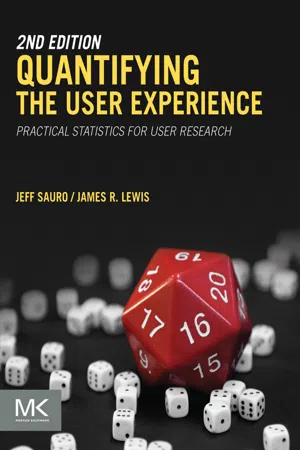
Quantifying the User Experience
Practical Statistics for User Research
Jeff Sauro,James R Lewis
- 350 pages
- English
- ePUB (adapté aux mobiles)
- Disponible sur iOS et Android
Quantifying the User Experience
Practical Statistics for User Research
Jeff Sauro,James R Lewis
À propos de ce livre
Quantifying the User Experience: Practical Statistics for User Research, Second Edition, provides practitioners and researchers with the information they need to confidently quantify, qualify, and justify their data. The book presents a practical guide on how to use statistics to solve common quantitative problems that arise in user research. It addresses questions users face every day, including, Is the current product more usable than our competition? Can we be sure at least 70% of users can complete the task on their first attempt? How long will it take users to purchase products on the website?
This book provides a foundation for statistical theories and the best practices needed to apply them. The authors draw on decades of statistical literature from human factors, industrial engineering, and psychology, as well as their own published research, providing both concrete solutions (Excel formulas and links to their own web-calculators), along with an engaging discussion on the statistical reasons why tests work and how to effectively communicate results. Throughout this new edition, users will find updates on standardized usability questionnaires, a new chapter on general linear modeling (correlation, regression, and analysis of variance), with updated examples and case studies throughout.
- Completely updated to provide practical guidance on solving usability testing problems with statistics for any project, including those using Six Sigma practices
- Includes new and revised information on standardized usability questionnaires
- Includes a completely new chapter introducing correlation, regression, and analysis of variance
- Shows practitioners which test to use, why they work, and best practices for application, along with easy-to-use Excel formulas and web-calculators for analyzing data
- Recommends ways for researchers and practitioners to communicate results to stakeholders in plain English